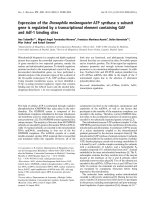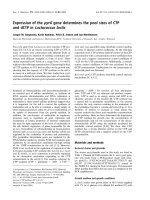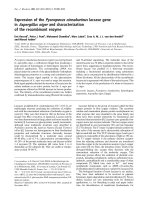Báo cáo khoa học: " Expression of Recombinant Porcine Interleukin-2 and Application of Its Antibody to Immunoassays" doc
Bạn đang xem bản rút gọn của tài liệu. Xem và tải ngay bản đầy đủ của tài liệu tại đây (200.01 KB, 6 trang )
JOURNAL OF
Veterinary
Science
J. Vet. Sci. (2002), 3(3), 207-212
Abstract
10)
Interleukin-2 plays an important role in T
lymphocyte proliferation and immune response regul-
ations. In this study, porcine IL-2 cDNA was cloned
from peripheral blood mononuclear cells, and recom-
binant porcine IL-2 (rpIL-2) was expressed in Escherichia
coli. The size of rpIL-2 without signal peptides was
about 15 kDa when determined by SDS-PAGE and
Western blotting analysis. Anti-rpIL-2 antibody was
produced from mice immunized with the purified
rpIL-2, and its specificity was examined by Western
blotting and ELISA. In the Western blotting assay,
anti-rpIL-2 and anti-recombinant human IL-2 (rhIL-2)
antibodies specifically recognized rpIL-2 and rhIL-2,
respectively. However, anti-rpIL-2 antibody did not
recognize rhIL-2, and anti-rhIL-2 antibody also did
not react with rpIL-2 in the same assay. In ELISA,
anti-rpIL-2 antibody strongly interacted with both
rpIL-2 and rhIL-2, and anti-rhIL-2 antibody also effici-
ently recognized both proteins. Taken together, the
specificity of anti-rpIL-2 antibody for rpIL-2 was
demonstrated by Western blotting and ELISA. It was
also shown that ELISA is more efficient than Western
blotting in determining the species cross-reactivity of
anti-rpIL-2 antibody.
Key words : porcine IL-2, expression, antibody, specificity,
species cross-reactivity
Introduction
Interleukin-2 (IL-2) was originally identified as a T cell
growth factor in the supernatants of lectin-stimulated
human and mouse T lymphocytes [11, 21, 26]. IL-2 plays a
number of important roles in the regulation of immune
responses, including the proliferation of activated T lymphocytes,
*
Corresponding author:
Tel. : +82-31-290-2737, Fax : +82-31-290-2737
E-mail :
the generation of cytotoxic T lymphocytes (CTL), increased
natural killer (NK) cell activity, and the production of
interferon and antibodies [8, 10, 14, 23, 28, 30]. The IL-2 of
several species, such as human, pig, and bovine, induces the
proliferation of their own T cells and also shows species
cross-reactivity, by supporting the growth of other animals
Tcells[5,6,7].
IL-2cDNAsfromseveralspecieshavebeencloned,
including human, mouse, pig, bovine, and ovine [2, 12, 13,
18, 29]. The molecular weight of their IL-2 is about 15-17
kDa [5, 23, 25]. The production of porcine IL-2 from
phytohemagglutinin (PHA) and concanavalin A (Con A)-
stimulated T lymphocytes has been observed, and its
characteristics determined by biological and biochemical
studies [9, 16]. There are relatively few reports on porcine
IL-2 expression in the baculovirus or E. coli system [5, 15,
17]. Iwata et al. (2000) reported upon the production of IL-2
antiserum from mice using a glutathione S-transferase
(GST)-IL-2 fusion protein as an antigen. In addition, no
study to the best of our knowledge has shown the develop-
ment of immunoassays for detecting porcine IL-2 in blood.
Swine viral diseases caused by pseudorabies virus and
circovirus are characterized by inducing the suppression of
host immune functions [3, 24]. In the case of pseudorabies
virus infection, immune suppression is mediated by the
inhibition of IL-2 production [3]. Since IL-2 is deeply involved
in the regulation of cellular immune responses against viral
infection, its modulation status may be correlated with some
viral disease developments. Because of its efficiency and
sensitivity, ELISA is broadly used to determine cytokine
variations in animal blood. The main purpose of this study
was to develop a porcine IL-2-specific ELISA system. In
order to do this, we expressed rpIL-2 in the E. coli system,
produced mono-specific polyclonal antibody from mice, and
examined the specificity of the antibody by Western blot and
ELISA. The ELISA system developed in this study may be
further applied to study the modulation of IL-2 expression
in virus-infected pigs.
Expression of Recombinant Porcine Interleukin-2 and Application of
Its Antibody to Immunoassays
In-Soo Choi and Han-Sang Yoo
*
Department of Infectious Diseases, College of Veterinary Medicine and School of Agricultural Biotechnology,
Seoul National University, Suwon 441-744, Korea
Received February. 8, 2002 / Accepted July 20, 2002
208 In-Soo Choi and Han-Sang Yoo
Materials and Methods
Cloning of porcine IL-2 cDNA
Porcine IL-2 gene was amplified by PCR using cDNA as
a template and a pair of primers as described elsewhere [4].
Briefly, single-stranded cDNA was synthesized from 5㎍ of
total RNA prepared from phytohemagglutinin (PHA)-stimulated
porcine peripheral blood mononuclear cells (PBMC) using a
Superscript Preamplification System for First Strand cDNA
Synthesis Kit (Gibco BRL, Grand Island, NY). The open
reading frame (ORF) region of IL-2 was then amplified for
30 cycles with a primer set #1 (Table 1) under the following
PCR conditions; 94℃ for 30 sec, 53℃ for 30 sec, and 72℃
for 45 sec. The pure PCR product was cloned into TOPO TA
cloning vector (Invitrogen, Carlsbad, CA) producing pTopoIL-2.
The identity of the IL-2 gene was confirmed by DNA
sequencing and restriction enzyme analysis.
Expression of recombinant porcine IL-2 protein
In order to subclone IL-2 cDNA into an expression vector, a
new pair of primers, set #2 (Table 1), was synthesized. The
forward and backward primers included the restriction enzyme
sites of Bam HI and Hind III at the 5’ end of the primers,
respectively. IL-2 cDNA, without a signal sequence, was
amplified for 30 cycles with primer set #2 and pTopoIL-2 as a
template under the following PCR conditions; 94℃ for 30 sec, 5
5℃ for 30 sec, and 72℃ for 45 sec. The PCR product was
cloned into TOPO TA cloning vector, and the insert DNA was
digested with Bam HI and Hind III. Digested insert DNA was
purified with a gel extraction kit (Qiagen, Hilden, Germany)
and ligated into the Bam HI- and Hind III-digested pQE-30
expression vector (Qiagen) that contains a sequence encoding a
methionine and 6xHistidine at the N-terminus. The ligation
reaction product was transformed into M-15 competent cells
(Qiagen), and a clone containing IL-2 cDNA was selected and
named as pQEIL-2. When the bacterial culture reached an
OD
600
of 0.6, the expression of IL-2 was induced by the addition
of IPTG into the bacterial culture to a final concentration of
1mM. After 4 h of culture in a shaking incubator at 185 rpm,
the bacteria were harvested by centrifugation at 4,000 × gfor
20 min, and the bacterial pellet was stored at -70℃ until
required for analysis.
Purification of rpIL-2
The bacterial pellet was resuspended in 45 ml of lysis
buffer (100 mM NaH
2
PO
4
,10mMTriscl,8MUrea,0.5%
Triton X-100, 10 mM Imidazloe, pH 8.0) and sonicated 10
times for 30 sec (Bandelin, Germany). The clear cell lysate
waspassedthreetimesthroughacolumnpackedwith
ProBond Resin (Invitrogen) that specifically bound 6xHis-
tagged recombinant protein. The column was washed three
times with 15 ml of wash buffer (100 mM NaH
2
PO
4
,10mM
Tris.Cl, 8 M Urea, 20 mM Imidazloe, and pH 8.0). The
rpIL-2 was eluted with 10 ml of elution buffers (100 mM
NaH
2
PO
4
, 10 mM Tris.Cl, 8 M Urea, 50 mM Imidazloe)
havingthreedifferentpHs,i.e.,pH6.7,6.3,and5.9.
Production of mono-specific polyclonal antibody
Mono-specific polyclonal antibody against rpIL-2 prepared
in E. coli was produced from mice. Four weeks old ICR mice
(Dae Han Biolink, Korea) were intraperitoneally and
subcutaneously immunized with 100 ㎍ of rpIL-2 mixed
with Freund's complete adjuvant (Gibco BRL). The second
immunization was conducted by injecting the same amount
of rpIL-2 mixed with Freund’s incomplete adjuvant 2 weeks
after the first immunization. The third immunization was
completed in the same way as the second, 3 weeks after the
first injection. Blood samples were collected from the mice
1 week after the final immunization. Sera were separated
from the blood and stored at -20℃ until use.
SDS-PAGE and Western blot
Lysates of bacteria induced or not induced with IPTG,
and the column-purified rpIL-2 samples were analyzed by
SDS-PAGE using 15% polyacrylamide gel. After SDS-PAGE,
the protein bands were visualized by Coomassie Brilliant
Blue staining.
The rpIL-2 and rhIL-2 prepared in two 15% polyacrylamide
gels were electrophoretically transferred onto two separate
nitrocellulose membrane papers (Bio Rad, Hercules, CA)
using a semidry transfer method. The nitrocellulose membrane
papers were blocked overnight with 5% skim milk in TBS.
After three washes with TTBS (0.05% Tween 20), one
membrane was incubated with mouse anti-rpIL-2 antibody,
and the other with rabbit anti-rhIL-2 antibody for 2 h at
room temperature. The membranes were washed three
times with TTBS, and incubated with the alkaline
phosphatase (AP)-conjugated goat anti-mouse IgG (H+L) or
goat anti-rabbit IgG (H+L) (Bio-Rad) for 2 h at room
temperature. After washing, the reacted bands were
Table 1. Primer sets used for the cloning and subcloning of porcine IL-2 cDNA.
Primer Set Nucleotide sequence Size of PCR product
Set#1
Forward
Backward
Set#2
Forward
Backward
5′-ATGTATAAGATGCAGCTCTTG-3′
5′-TCAAGTCAGTGTTGAGTAGATG-3′
5′-GGATCCGCACCTACTTCAAGCTC-3′
5′-AAGCTTTCAAGTCAGTGTTGAGTAG-3′
465bp
417bp
Expression of Recombinant Porcine Interleukin-2 and Application of Its Antibody to Immunoassays 209
visualized by color development with AP color developer
(Bio-Rad) as described by the manufacturer.
ELISA
The specificity of the polyclonal antibody produced from
the rpIL-2-immunized mice for recombinant porcine and
human IL-2 was examined by ELISA. One hundred ㎕ of
rpIL-2 (10 ㎍/1 ml) and rhIL-2 (10 ㎍/1 ml) resuspended in
the coating buffer (14.2 mM Na
2
CO
3
, 34.9 mM NaHCO
3
,3.1
mM NaN
3
, pH 9.6) was added to a microplate for ELISA
(Greiner, Austria), and incubated overnight at 4℃.The
plate was washed three times with PBST (0.05% Tween 20),
and blocked with PBST containing 1% bovine serum
albumin (BSA) for 1 h at 37℃. As the first antibody, 100 ㎕
of 1:100-diluted mouse anti-rpIL-2 polyclonal antibody or
1:1,000-diluted rabbit anti-rhIL-2 (Endogen, Woburn, MA)
was added to the plate, and incubated for 1 h at 37℃.After
washing with PBST, 100 ㎕ of goat anti-mouse IgG
(H+L)-HRP conjugate (Bio-Rad) or goat anti-rabbit IgG
(H+L)-HRP conjugate (Bio-Rad) was added to the plate, and
incubated for 1 h at 37℃. Color was developed by adding
100 ㎕ of ABTS substrate solution (Bio-Rad) to the plate.
After 30 min of incubation at room temperature, the OD
value was measured at 405 nm using an ELISA reader
(Molecular Devices, Sunnyvale, CA).
Results
Cloning and expression of rpIL-2 in E. coli
TheORFofporcineIL-2composedof465bpencoding
154 amino acids was cloned into TOPO TA cloning vector.
Subsequent DNA sequencing demonstrated that the cloned
insert DNA was 100% identical with the reference porcine
IL-2 cDNA sequence (data not shown) [13]. IL-2 cDNA
without signal sequences was cloned into TOPO TA vector
(Fig. 1), and then subcloned into an expression vector
pQE30. Expression of rpIL-2 was induced by the addition of
IPTG to the bacterial culture (Fig. 2).
Fig. 1. Cloning of porcine IL-2 cDNA. Porcine IL-2 gene
without a signal sequence was amplified by PCR with a
forward primer containing a Bam HI site and a backward
primer containing a Hind III site at their 5’ ends. The PCR
product was cloned into a TOPO TA cloning vector. Plasmid
DNA having the correct insert was digested with Bam HI
and Hind III,andanalyzedinan1.5%agarosegel.
Fig. 2. Expression of recombinant porcine IL-2 protein in E.
coli. Expression of rpIL-2 was induced by the addition of IPTG
into bacterial culture, and analyzed in a 15% polyacrylamide
gel. The expressed recombinant IL-2 was identified as a 15
kDa band in the gel. M: standard protein marker; Lane 1:
induction with IPTG; Lane 2: no induction with IPTG.
Determination of protein purification conditions
and the size of rpIL-2
The affinity column-purified rpIL-2 composed of 146
amino acids, including 134 amino acids of IL-2, and
additional 6 amino acids and 6xHistidine-tags at the
N-terminus of the vector, appeared as a single band of 15
kDa by SDS-PAGE analysis (Fig. 3). The fractions eluted by
elution buffers of pH 6.7-5.9 showed rpIL-2 as a clear single
band. However, elution buffers with pHs lower than pH 5.9
eluted contaminated proteins with the IL-2 protein under
our experimental conditions (data not shown). These results
indicate the importance of optimal pH in the elution step of
recombinant protein. A comparison of the recombinant
porcine and human IL-2 by SDS-PAGE demonstrated that
two proteins were of almost the same size, 15 kDa (Fig. 4).
Fig. 3. Purification of recombinant porcine IL-2. Recombinant
porcine IL-2 containing 6xHis at its N-terminus was
purified using ProBond
TM
resin under the denaturing
210 In-Soo Choi and Han-Sang Yoo
conditions. M; standard protein marker; Lane 1: bacteria
lysate; Lane 2: flow-through; Lane 3: first washing; Lane 4:
second washing; Lane 5: third washing; Lane 6: first
elution; Lane 7: second elution; Lane 8 third elution.
Fig. 4. Electrophoretic analysis of purified recombinant
porcine IL-2 and recombinant human IL-2 in 15% SDS-
polyacrylamide gel. M: standard protein marker; Lane 1:
porcine IL-2; Lane 2: human IL-2.
Specificity and cross-reactivity of anti-rpIL-2 antibody
The mono-specific polyclonal antibody was produced from
mice immunized with rpIL-2. To test the specificity of the
antibody, Western blotting was conducted with porcine and
human IL-2. Mouse anti-rpIL-2 antibody specifically and
strongly interacted with rpIL-2 (Fig. 5A). However, it was
too weak to identify a rhIL-2-specific band. On the other
hand, the commercial rabbit anti-rhIL-2 readily recognized
the rhIL-2 antigen (Fig. 5B), but did not clearly produce a
rpIL-2-specific signal. These results indicate that the Western
blotting assay does not efficiently demonstrate the species
cross-reactivity of the antibodies for the recombinant IL-2
proteins. Therefore, ELISA was developed to demonstrate
both specificity and cross-reactivity of the antibodies. Mouse
anti-rpIL-2 antibody very strongly recognized both pig IL-2
and human IL-2 (Fig. 6). The OD values against rpIL-2 and
rhIL-2 were 3.27±0.33 and 2.56±0.41, respectively. Rabbit
anti-rhIL-2 antibody also specifically reacted with human
and porcine IL-2 (Fig. 6). The corresponding OD values
against rhIL-2 and rpIL-2 were 3.74±0.10 and 2.79±0.03,
respectively. The ELISA results definitely reflected the
specific interactions between the anti-rpIL-2 and anti-rhIL-2
antibodies and the porcine and human IL-2 proteins, and
also showed species cross-reactivity.
(A)
(B)
Fig. 5. Western blotting analysis of purified recombinant
porcine IL-2 and recombinant human IL-2. Porcine and
human IL-2 proteins were transferred onto two nitrocellulose
membranes. One of them was incubated with mouse
anti-rpIL-2 antibody (A), and the other with rabbit anti-rhIL-2
antibody (B). The membranes were incubated with goat
anti-mouse IgG (H+L)-AP conjugate and goat anti-rabbit
IgG (H+L)-AP conjugate, respectively. IL-2-specific bands
were identified by the addition of AP color development
buffer to the membranes. M: standard protein marker; Lane
1: porcine IL-2; Lane 2: human IL-2.
Fig. 6. Cross-reactivity of anti-rpIL-2 and anti-rhIL-2
antibodies with rpIL-2 and rhIL-2 in ELISA. Porcine and
Expression of Recombinant Porcine Interleukin-2 and Application of Its Antibody to Immunoassays 211
human recombinant IL-2 was coated on the ELISA plate,
and incubated with different antibodies, including mouse
negative serum, mouse anti-rpIL-2 antibody, or rabbit
anti-rhIL-2 antibody. Goat anti-mouse IgG (H+L)-HRP
conjugate or goat anti-rabbit IgG (H+L)-HRP conjugate was
used as secondary antibodies. After color development, by
adding substrate solution, OD values were determined at
405 nm with an ELISA reader.
Discussion
IL-2 produced from activated T lymphocytes induces T
cell proliferation, and regulates a broad range of cellular
immune responses by interacting with its high affinity
receptor [23, 28]. Some animal viruses, such as human
immunodeficiency virus (HIV), simian immunodeficiency virus
(SIV), and pseudorabies virus (PRV), induce a suppression
of immune response by inhibiting IL-2 production during
infections [3, 20, 27]. It may also be speculated that the
porcine circovirus (PCV)-induced immunosuppression pheno-
menon is a consequence of the disturbance of cytokine-
mediated immune responses [24]. As the first step in
conducting a project designed to study the interaction
between disease development and porcine cytokine modulation,
we prepared recombinant porcine IL-2 and antisera against
it to develop immunoassays, which would be applied to
study the modulation of IL-2 expression in pathogen-
infected pigs.
ThesizeofrpIL-2expressedinE. coli was about 15 kDa
when determined by SDS-PAGE, as shown in other reports
[5, 17]. The mono-specific polyclonal antibody produced from
mice with rpIL-2 readily detected the recombinant protein of
the same size in Western blotting assay, demonstrating the
specificity of the antibody for the rpIL-2 antigen. However,
the same antibody barely detected rhIL-2 in the same
conditions of Western blotting assay. The commercial rabbit
anti-rhIL-2 antibody also did not recognize rpIL-2 in
Western blotting assay. The reason for the extremely poor
recognition of human IL-2 by mouse anti-rpIL-2 antibody
and porcine IL-2 by rabbit anti-rhIL-2 in Western blotting
is attributable to the reactivity of the antibodies in the
assay-specific conditions. On the other hand, both mouse
anti-rpIL-2 and rabbit anti-rhIL-2 antibodies very efficiently
recognized both rpIL-2 and rhIL-2 in ELISA demonstrating
both the specificity and species cross-reactivity of the
antibodies. However, mouse anit-rpIL-2 antibody always
recognized rpIL-2 more strongly than rhIL-2 (p<0.05).
Similarly, rabbit anti-rhIL-2 antibody produced higher OD
values with rhIL-2 than that with rpIL-2 (p<0.01). The
predicted amino acid sequences of human and porcine IL-2
cDNA exhibit 72% homology [13]. The OD values obtained
by ELISA with two antibodies would reflect the difference of
amino acid sequences of the two proteins.
Co-delivery of IL-2 with vaccines for pseudorabies virus
(PRV), influenza virus, or bovine viral diarrhea virus
(BVDV), induces enhanced and protective immune responses
[1, 19, 22]. Therefore, it is highly promising that rpIL-2
prepared in this study, if it has biological or functional
activity, may be used as an adjuvant in the development of
efficient porcine viral vaccines. Based on the polyclonal
antibody prepared in this study, we intend to produce
monoclonal antibodies specific for several epitopes of rpIL-2.
These reagents will be valuably used for evaluating the
immunomodulatory effect of viral diseases and for
performing more sophisticated immunological assays.
Acknowledgments
This study was supported by grant No. 0999-011-1-2 from
the Agricultural Research and Promotion Center, and by
grants from the Brain Korea 21 project, and from the
Research Institute for Veterinary Science, Seoul National
University, Korea.
References
1. Babai I., Barenholz Y., Zakay-Rones Z., Greenbaum
E.,SamiraS.,HayonI.,RochmanM.,andKedarE.
A novel liposomal influenza vaccine (INFLUSOME-VAC)
containing hemagglutinin-neuraminidase and IL-2 or
GM-CSF induces protective anti-neuraminidase antibodies
cross-reacting with a wide spectrum of influenza A viral
strains. Vaccine 2002, 20, 505-515.
2. Cerretti D. P., McKereghan K., Larsen A., Cantrell
M.A.,AndersonD.,GillisS.,CosmanD.,and
Baker P. E. Cloning, sequence, and expression of
bovine interleukin 2. Proc. Natl. Acad. Sci. USA 1986,
83, 3223-3227.
3. Chinsakchai S., and Molitor T. W. Replication and
immunosuppressive effects of Pseudorabies virus on
swine peripheral blood mononuclear cells. Vet. Immunol.
Immunopathol. 1992, 30,247-60.
4. ChoiI.S.,ShinS.J.,andYooH.S.Modulatory
effects of ionized alkali mineral complex (IAMC) on
mRNA expression of porcine cytokines. J. Vet. Med. Sci.
2001, 63, 1179-1182.
5. CollinsR.A.,TaytonH.K.,GelderK.I.,BrittonP.,
and Oldham G. Cloning and expression of bovine and
porcine interleukin-2 in baculovirus and analysis of
species cross-reactivity. Vet. Immunol. Immunopathol.
1994, 40, 313-324.
6. Denyer M. S., Martin S., and Wardley R. C. Cross
reactions between porcine, bovine and ovine interleukin-2
preparations.Res.Vet.Sci.1987,42, 252-254.
7. English L. S., Binns R. M., and Licence S. T.
Characterization of pig T cell growth factor and its
species-restricted activity on human, mouse and sheep
cells.Vet.Immunol.Immunopathol.1985,9,59-69.
8. Farrar W. L., Johnson H. M., and Farrar J. J.
Regulation of the production of immune interferon and
212 In-Soo Choi and Han-Sang Yoo
cytotoxic T lymphocytes by interleukin 2. J. Immunol.
1981, 126, 1120-1125.
9. Gasbarre L. C., Urban J. F. Jr., and Romanowski
R. D. Porcine interleukin 2: parameters of production
and biochemical characterization. Vet. Immunol. Immu-
nopathol. 1984, 5, 221-236.
10. Gillis S., and Smith K. A. Long term culture of tumor-
specific cytotoxic T cells. Nature 1977, 268, 154-156.
11. GillisS.,FermM.M.,OuW.,andSmithK.A.Tcell
growth factor: parameters of production and a
quantitative microassay for activity. J. Immunol. 1978,
120, 2027-2032.
12. Goodall J. C., Emery D. C., Perry A. C., English L.
S., and Hall L. cDNA cloning of ovine interleukin 2 by
PCR. Nucleic Acids Res. 1990, 18, 5883.
13. GoodallJ.C.,EmeryD.C.,BaileyM.,EnglishL.S.,
and Hall L. cDNA cloning of porcine interleukin 2 by
polymerase chain reaction. Biochim. Biophys. Acta 1991,
1089, 257-258.
14. Henney C. S., Kuribayashi K., Kern D. E., and
Gillis S. Interleukin-2 augments natural killer cell
activity. Nature 1981, 291,335-338.
15. HyunB.H.,SongJ.Y.,LeeJ.B.ChaS.H.,Park
J. H., Lee J. O., An D. J., Kang Y. W., and An S. H.
Cloning and expression of porcine interleukin-2 gene in
Escherichia coli. RDA J. Vet. Sci. 1997, 39, 42-50.
16. Iwata H., Ueda T., Takayanagi K., Wada M., and
Inoue T. Swine interleukin 2 activity produced by
mesentericlymphnodecells.J.Vet.Med.Sci.1993,55,
729-734.
17. Iwata H., Yamamoto M., Hasegawa A., Kurata K.,
and Inoue T. Expression of porcine interleukin-2 in
Escherichia coli.J.Vet.Med.Sci.2000,62, 1101-1104.
18. Kashima N., Nishi-Takaoka C., Fujita T., Taki S.,
Yamada G., Hamuro J., and Taniguchi T. Unique
structure of murine interleukin-2 as deduced from
cloned cDNAs. Nature 1985, 313,402-404.
19. Kawashima K., and Platt K. B. The effect of human
recombinant interleukin-2 on the porcine immune response
to a pseudorabies virus subunit vaccine. Vet. Immunol.
Immunopathol. 1989, 22, 345-353.
20. Koopman G., Niphuis H., Newman W., Kishimoto
T. K., Maino V. C., Heeney J. L. Decreased expression
of IL-2 in central and effector CD4 memory cells during
progression to AIDS in rhesus macaques. AIDS 2001,
15, 2359-2369.
21. Morgan D. A., Ruscetti F. W., and Gallo R. Selective
in vitro growth of T lymphocytes from normal human
bone marrows. Science 1976, 193, 1007-1008.
22. Nobiron I., Thompson I., Brownlie J., and Collins
M. E. Co-administration of IL-2 enhances antigen-specific
immune responses following vaccination with DNA
encoding the glycoprotein E2 of bovine viral diarrhea
virus. Vet. Microbiol. 2000, 76,129-142.
23. Robb R. J. Interleukin 2: the molecule and its function.
Immunol. Today 1984, 5, 203-209.
24. Sato K., Shibahara T., Ishikawa Y., Kondo H.,
Kubo M., and Kadota K. Evidence of porcine circovirus
infection in pigs with wasting disease syndrome from
1985 to 1999 in Hokkaido, Japan. J. Vet. Med. Sci.
2000, 62, 627-633.
25. Seow H. F., Mucha M. J., Hurst L., Rothel J. S.,
and Wood P. R. Expression of ovine interleukin-2
cDNA in Escherichia coli. Vet. Immunol. Immunopathol.
1997, 56, 107-117.
26. ShawJ.,MonticoneV.,andPaetkauV.Partial
purification and molecular characterization of a
lymphokine (costimulator) required for the mitogenic
response of mouse thymocytes in vitro.J.Immunol.
1978, 120, 1967-1973.
27. SiegS.F.,BazdarD.A.,HardingC.V.,andLederman
M. M. Differential expression of interleukin-2 and
gamma interferon in human immunodeficiency virus
disease. J. Virol. 2001, 75, 9983-9985.
28. Smith K. A. Interleukin-2: inception, impact, and
implications. Science 1988, 240, 1169-1176.
29. Taniguchi T., Matsui H., Fujita T., Takaoka C.,
Kashima N., Yoshimoto R., and Hamuro J.
Structure and expression of a cloned cDNA for human
interleukin-2. Nature 1983, 302, 305-310.
30. WagnerH.,HardtC.,HeegK.,RollinghoffM.,and
Pfizenmaier K. T-cell-derived helper factor allows in
vivo induction of cytotoxic T cells in nu/nu mice. Nature
1980, 284,278-279.

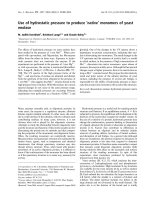
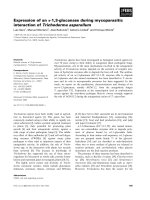
![Tài liệu Báo cáo khoa học: Expression of two [Fe]-hydrogenases in Chlamydomonas reinhardtii under anaerobic conditions doc](https://media.store123doc.com/images/document/14/br/hw/medium_hwm1392870031.jpg)


